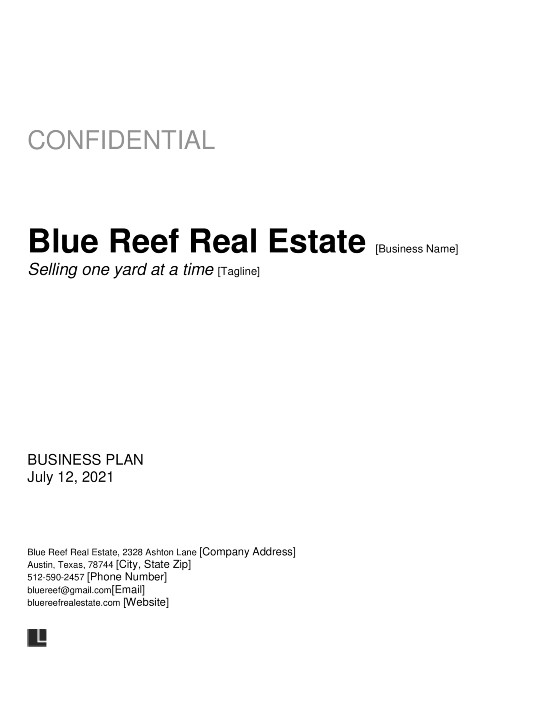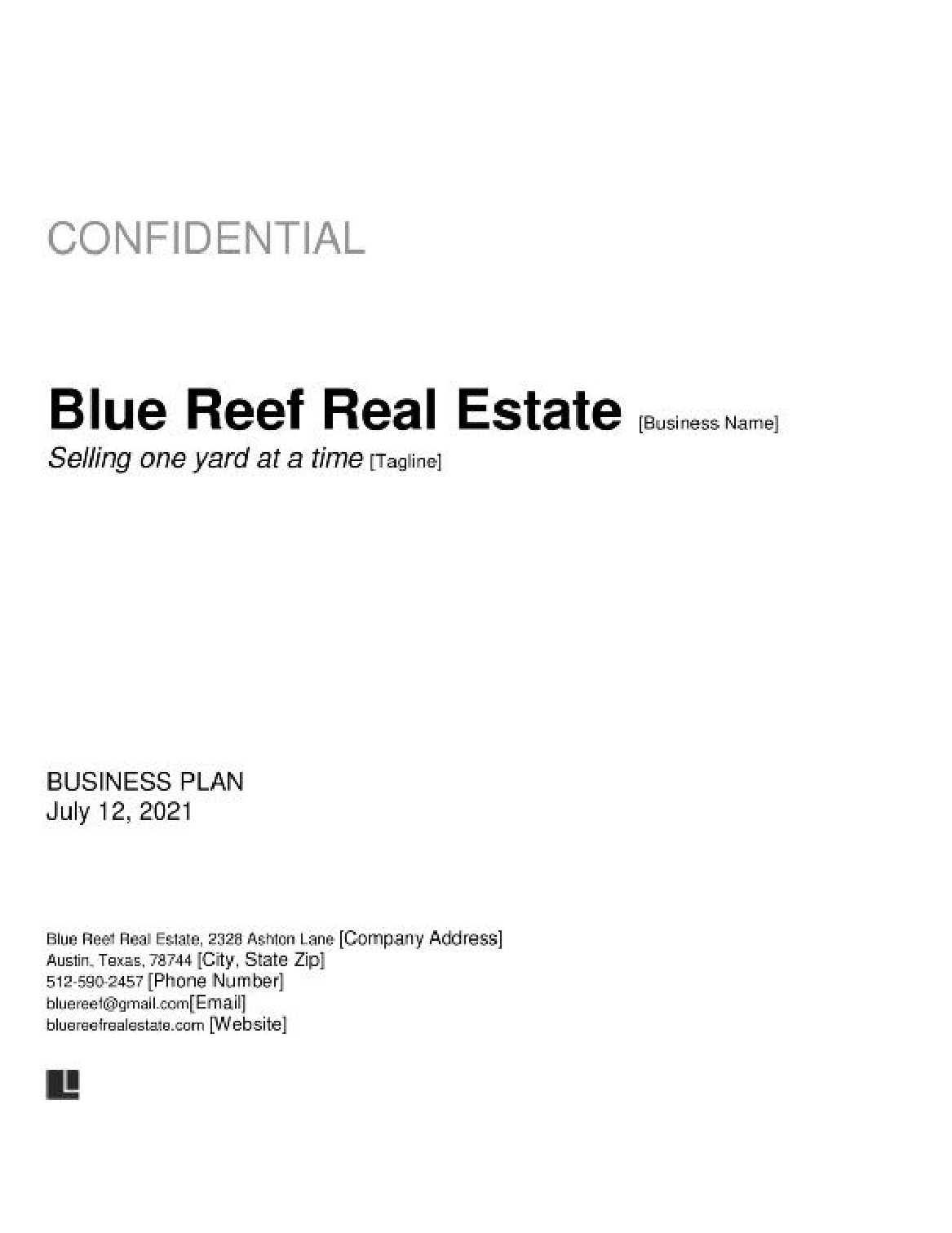A real estate business plan is as essential as a business plan for any new or existing business. This step-by-step guide will explain how to make a real estate business plan, provide a real estate business plan template for you to work with, and explain how and why each step is necessary for your business plan to be effective.
We also provide links to downloadable templates to help you create your real estate business plan and sample plans to show you the best ways to tailor your plan for any number of real estate business needs.
Whether you seek investors to grow your business or want to track your goals from year to year as your business develops, a carefully crafted plan will help you.
Why You Need a Business Plan for Your Real Estate Business
The real estate business plan fills several needs. It gives you an outline of your business goals and the direction you want your business to take. It keeps you in line with industry trends. It lets you monitor your annual performance and change your goals as the market changes.
An effective real estate business plan also acts as a financial summary of your business, showing how it stands about your competition and the industry. The business plan acts as a road map for you and a snapshot of your business for any investors or bankers who want to understand your business.
A real estate business plan will help you spot risks and weaknesses early in your business development and help you set realistic goals for your business.
These are known as SMART goals: Specific, Measurable, Achievable, Relevant, and Time-based goals.
Creating a business plan without goals is like starting a journey without a destination. Having a destination without a map means going down many blind alleys, taking unnecessary detours, and wasting time as you frequently need to return and start again.
Your business plan will help you avoid these pitfalls and adjust your course while you travel towards your final goal — a successful real estate business.
How to Write a Business Plan For Real Estate
You must cover critical topics and include the correct information to ensure your business plan is as effective as possible. Follow our guide to writing a well-formed real estate business plan below.
1. Executive Summary
The executive summary contains an overall review of the rest of the business plan. It should include an outline of your history, your mission statement, and an overview of the rest of the report.
This section will include things like:
- Target clients with a fictional “ideal buyer” persona;
- Target neighborhoods, price ranges, and listings;
- Market overviews and potential threats and opportunities;
- A marketing plan outline.
- Your mission statement. This should include where and how your agency was founded, discuss the legal and financial structure, and stress your dedication to your customers and any special advantages you provide to your target clients.
2. Management Team
If you have a management team or a group that has contributed to the business’s success, summarize their names and contributions.
This section highlights everyone who has been involved in your business.
- Owners, founders, and original managers;
- New management, assigned duties and areas, and specific clients;
- Planned management expansion and anticipated managerial goals.
- Include all information about your managers, names, positions and duties, education and work history, past business successes, and other relevant details. Think of this section as your management team’s biography.
As the business expands, your management team section will be one section that needs constant improvement and updating.
3. Products and Services
Your products and services should be phrased to make you unique in the industry and highlight how you stand out from your competitors. As a real estate business, what do you provide for your clients that others do not? How do your agents compare with your competition?
In real estate, your product is your listing and your brand. What is it that makes your company the one that your target buyer wants to use? In this section, you will highlight the following:
- Your niche market and how you acquire specific listings in your area;
- Your lead generation model and the way you obtain leads that differentiate you from your competitors;
- Your branding. A defining brand can be nebulous, and many firms resort to hiring a brand agent to help them customize and market their brand. You may be a family-friendly agent or specialize in the young professionals market. Determining how you present yourself is critical to your service profile.
4. Customers and Marketing
The customers and marketing section lets you identify your niche within the real estate business and how you intend to reach them.
You defined your ideal customer in your executive summary; now is where you expand on your perfect customer “persona.” A “persona” is the industry name for the imaginary person you sell to.
- Their demographics, age, gender, job, family preference, and income.
- Deal-breakers. What do they have to have in a home? What can they do without?
- Amenities, recreation, entertainment. Does your ideal buyer need dog parks nearby or bike paths? Do they want access to the water or the theater district?
- What type of neighborhood is your ideal buyer looking for? Do they need a school district or prefer to be far from children?
After establishing your ideal customer, you can select the viability of your marketing niche. For instance, is your buyer likely to be a first-time buyer? If so, what percentage of first-time sales were made in your chosen area in the last two years?
The more detailed you can make your Customers and Marketing section, the more you know how your business will likely thrive in your chosen area.
5. SWOT Analysis
Strengths, weaknesses, opportunities, and threats are necessary for every business analysis. In what areas are you and your business strongest, and where do you need improvement?
Investors appreciate a business owner who can accurately pinpoint their good and bad points and demonstrate how to improve.
This analysis should be fact-based, not opinion-based. You should be able to provide statistics and metrics for your and your competitors’ business research. Some things to consider are:
- In what areas of your business plan are you strongest? Are they similar or dissimilar to your nearest competitor’s strengths?
- In what areas are you weakest? Are you weak where your competitors are strongest?
- What opportunities can you exploit in the next six to 12 months? Are these opportunities unavailable to your competitors?
- What threats are you facing in the next year? How can you avoid these threats or turn them into advantages?
By analyzing your business objectively and reviewing all the facts and numbers, you can determine how you will be placed in the next year.
6. Financials
The meat of your business plan is the financials. This includes your expenses, annual income forecast (sales, commissions, or other income), cash flow, and costs. As your business grows, your business plan will include previous years’ financials to track the growth.
Your financials should include, at a minimum:
- Expenses. These include operating expenses, whether you have a physical location or are still in the virtual stage of operations, licensing and permitting, fees and filing costs, and other operating expenses. If you have employees, it will also include payroll.
- Income. The income section should consist of two parts.
- The past income portion will track how much you have already made. You should be able to show how many leads you have generated, how many transactions you made, and your income from those efforts.
- Future income is how much you would like to make going forward. You can estimate how many leads are needed per transaction and how many transactions per sale from your past efforts.
- Goals. With this information, you should include your projections for the next year and five-year periods. Presumably, you wish to increase profit over the next five years. You can demonstrate how to achieve these goals using income tracking and market research.
7. Operations
Operations contain the moving parts of your financial projections. This section describes how you intend to reach your business goals in the upcoming year. This section might also include upcoming personnel changes, office expansions, etc.
Real Estate operations can include your projected hours of operation, your action plan for achieving your goals, and your marketing and advertising plan. Initially, this may be somewhat fluid if you do not plan to have set hours of operation or a brick-and-mortar office.
Later, as your business increases, this section will include business hours, open house times, etc.
8. Appendix
If your real estate business plan includes any ancillary documents, such as your Articles of Incorporation or a Business Purchase Agreement, they would be included in the Appendix.
After your first real estate business plan, your previous years’ plans will go into the Appendix so they can be reviewed by potential investors or by your board. You can also include your quarterly statements and other financial documents.
Your Appendix is the section for any documents you want to have that are not essential for your readers’ overall understanding.
Now that you know what goes into your real estate business plan, all that is left for you to do is click on the business plan creation template and begin. Ensure you have all your documentation and research-ready in advance, and the template will provide you with cues as to what information needs to go into which spaces.
After filling in all the blanks, the template will generate a real estate business plan to your specifications.
Real Estate Business Plan Sample
Writing a real estate business plan is easier when you work from a template. Download a free real estate business plan template from LegalTemplates and start writing your business plan today.



